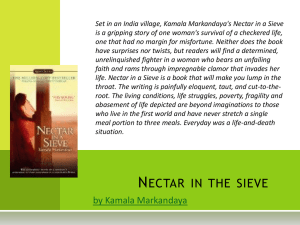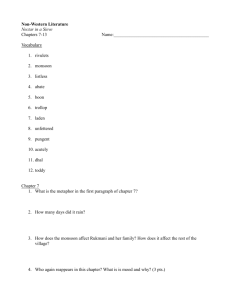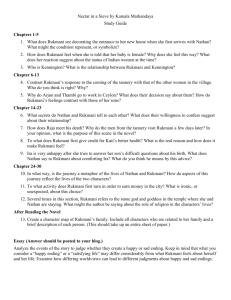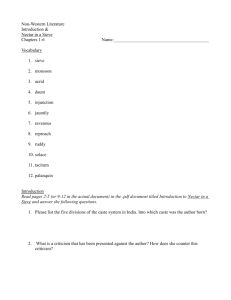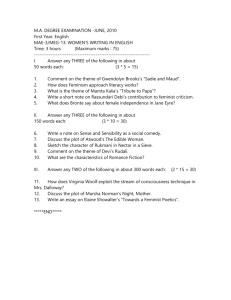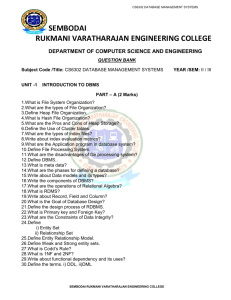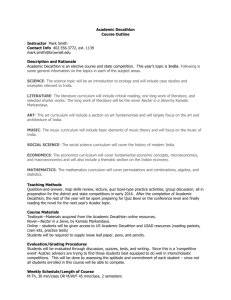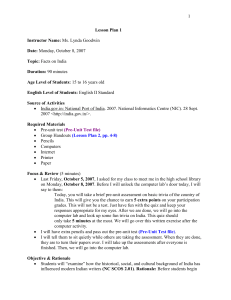The Value of Suffering in Kamala Markandaya's Nectar in a... Shoshana M. Landow '91 (Anthropology 302, Princeton University, 1989)
advertisement
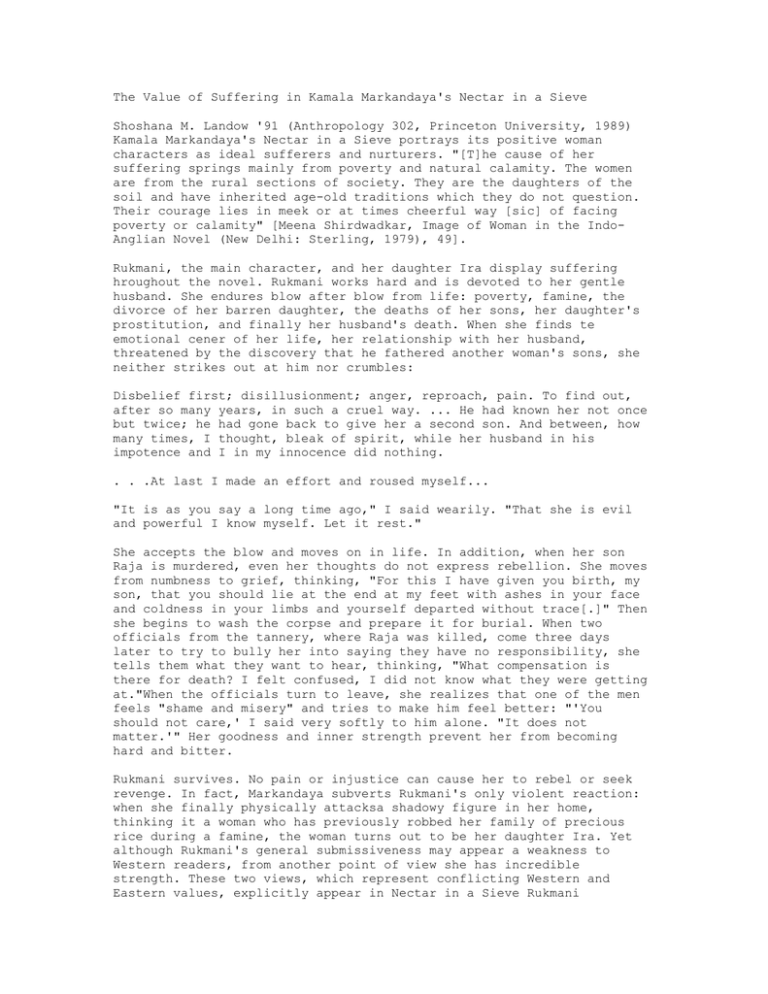
The Value of Suffering in Kamala Markandaya's Nectar in a Sieve Shoshana M. Landow '91 (Anthropology 302, Princeton University, 1989) Kamala Markandaya's Nectar in a Sieve portrays its positive woman characters as ideal sufferers and nurturers. "[T]he cause of her suffering springs mainly from poverty and natural calamity. The women are from the rural sections of society. They are the daughters of the soil and have inherited age-old traditions which they do not question. Their courage lies in meek or at times cheerful way [sic] of facing poverty or calamity" [Meena Shirdwadkar, Image of Woman in the IndoAnglian Novel (New Delhi: Sterling, 1979), 49]. Rukmani, the main character, and her daughter Ira display suffering hroughout the novel. Rukmani works hard and is devoted to her gentle husband. She endures blow after blow from life: poverty, famine, the divorce of her barren daughter, the deaths of her sons, her daughter's prostitution, and finally her husband's death. When she finds te emotional cener of her life, her relationship with her husband, threatened by the discovery that he fathered another woman's sons, she neither strikes out at him nor crumbles: Disbelief first; disillusionment; anger, reproach, pain. To find out, after so many years, in such a cruel way. ... He had known her not once but twice; he had gone back to give her a second son. And between, how many times, I thought, bleak of spirit, while her husband in his impotence and I in my innocence did nothing. . . .At last I made an effort and roused myself... "It is as you say a long time ago," I said wearily. "That she is evil and powerful I know myself. Let it rest." She accepts the blow and moves on in life. In addition, when her son Raja is murdered, even her thoughts do not express rebellion. She moves from numbness to grief, thinking, "For this I have given you birth, my son, that you should lie at the end at my feet with ashes in your face and coldness in your limbs and yourself departed without trace[.]" Then she begins to wash the corpse and prepare it for burial. When two officials from the tannery, where Raja was killed, come three days later to try to bully her into saying they have no responsibility, she tells them what they want to hear, thinking, "What compensation is there for death? I felt confused, I did not know what they were getting at."When the officials turn to leave, she realizes that one of the men feels "shame and misery" and tries to make him feel better: "'You should not care,' I said very softly to him alone. "It does not matter.'" Her goodness and inner strength prevent her from becoming hard and bitter. Rukmani survives. No pain or injustice can cause her to rebel or seek revenge. In fact, Markandaya subverts Rukmani's only violent reaction: when she finally physically attacksa shadowy figure in her home, thinking it a woman who has previously robbed her family of precious rice during a famine, the woman turns out to be her daughter Ira. Yet although Rukmani's general submissiveness may appear a weakness to Western readers, from another point of view she has incredible strength. These two views, which represent conflicting Western and Eastern values, explicitly appear in Nectar in a Sieve Rukmani confronts the Western doctor, Kenny, who urges, "'you must cry out if you want help. It is no use whatsoever to suffer in silence. Who will succour the drowning man if he does not clamour for his life?'" In response, Rukmani thinks, "Want is our companion from birth to death, familiar as the seasons or the earth, varying only in degree. What profit to bewail that which has always been and cannot change?" But Kenny, the Westerner, believes that, "there is no grandeur in want -or endurance." In contrast, Rukmani, the Indian woman, sees suffering as good for the spirit and endurance as a necessity, because she cannot change her situation. Looking at Rukmani only from the Western point of view leads one to misunderstand her character and the values that sustain her. The Western viewpoint equally misjudges the ideal of the devoted wife. Meena Shirwadkar, who hopes that women will emerge as uninhibited, multifaceted individuals in literature, perhaps regards the Sita-Savitri image from too Western a standpoint. She sees the role as a purely weak one forced upon women, when in fact Hindu culture conceives of self-sacrifice as a form of power. Ira's sacrifice for others makes her prostitution therefore compatibile with the virtuous ideal. As a result of her motivations, she remains a sympathetic character although she violates traditional mores. That Markandaya means for our sympathy to hinge on her self-sacrifice becomes even more obvious when one compares her and another prositute in the story, the evil Kunthi. Initially, this beautiful, fiery woman has a bad reputation for sleeping with other men besides her husband. She appears an unlikable person who rejects Rukmami. But as the plot progresses into famine, she becomes a hateful, destructive figure. Not only does Rukmani find out that her husband Nathan fathered Kunthi's two sons, but Kunthi uses this knowledge of Nathan's secret, and of a secret of Rukmani's, to coerce them separately into giving her the family's hidden rice. Kunthi's independence -- she refuses to ask her married sons for food, and her husband has abandoned her -- causes her to hurt others. She steals food from Rukmani's family so that she can regain some of her beauty for prostitution. Her illicit sexuality, unlike Ira's, always comes from self-motivated desire -- first lust then greed; she represents a negative ideal of woman, using cruelty, trickery and other people to satisfy her needs and desires. She even appears as a carrion-eater who benefits from the collapse of others, in her most hateful scene with the saintly Rukmani. After agonizing over whether to give Kunthi the rice Rukmani looks up and sees her: "there was Kunthi waiting by my side with the patience of one who knows what power she wields, patient, like a vulture." Feeding off the weaknesses of others, Kunthi contradicts the ideal image ofwoman as a nurturant, generative force. Rukmani and Ira appear in Nectar in a Sieve as opposites of Kunthi. Their goodness originates in their acceptance of suffering, whereas Kunthi's evil originates in her refusal to sacrifice herself for others. As ideal images, Markandaya's heroines correlate with Shirwadkar's conception of how early Indo-Anglian novels portray women as Sita-like characters. By fulfilling cultural values, however, Rukmani and Ira find in their way of lifenot only suffering but also a sureness and inner peace. Shirwadkar claims that women in later novels lose even the satisfaction of this fulfillment, because they find themselves trapped between the traditional and modern requirements for women. Earlier images of calm, enduring women change to new ones, of frustrated women caught between the Sita-Savitri figure and the modern, Westernized woman.
